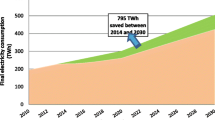Abstract
This paper assesses the potential mitigation of emissions by implementing minimum energy performance standard (MEPS) for residential TVs in Malaysia. The ownership of TVs in Malaysian household has increased rapidly over the past three decades. The number has increased from 186,036 units in 1970 to 2,741,640 units in 1991 and is predicted to be about 7,292,931 units in the year 2015. To reduce energy consumption in the residential sector, the Department of Electricity and Gas Supply is considering implementing MEPS for TVs in the coming year. In this study the potential reduction of emissions as a result of implementing MEPS is calculated. It has been estimated that the implementation of MEPS for residential TVs would reduce approximately 57,837,060 kg of CO2, 351,114 kg of SO2, 164,609 kg of NO x and 34,777 kg of CO emissions during the standard period of 10 years. These emissions reduction will eventually enable us to control environmental impacts such as global warming.


Similar content being viewed by others
Abbreviations
- AEI s :
-
annual efficiency improvement of TV (%)
- AS i :
-
applicable stock in year i of TV
- BEC s :
-
baseline energy consumption of TV (kWh/year)
- c, k :
-
constant values
- E o :
-
TV power consumption in active mode (W)
- E t :
-
TV power consumption in standby mode (W)
- \( Em^{n}_{p} \) :
-
Emission p for fuel type n for a unit electricity generation (kg/kWh)
- ER i :
-
emission reduction in year i of TV (kg)
- ES i :
-
energy saving in year i of TV (kWh)
- L :
-
life span of TV (Year)
- NA i :
-
number of TVs in year i
- NA i−1 :
-
number of TVs in year i−1
- NA i−L :
-
number of TVs in year i−L
- \( PE^{n}_{i} \) :
-
percentage of electricity generation in year i of fuel type n (%)
- RM:
-
Malaysian Ringgit (currency) [US$1.00=RM3.80]
- s :
-
year of standard enacted
- SF i :
-
scaling factor in year i of TVs (%)
- Sh i :
-
shipments in year i of TVs
- SEI s :
-
total efficiency improvement of TV (%)
- UES i :
-
initial unit energy savings in year i of TV (kWh/year)
- U o :
-
average hour/year TV in standby mode
- U t :
-
average hour/year TV in active mode
- x :
-
year predicted−year start
- y :
-
predicted value
- Yse s :
-
year standard enacted for TV
- Ysh i :
-
year i of shipment of TV
- η:
-
percentage improvement of TV (%)
References
Bernama Reports (2002) Banks urged to help realise new energy sources target. Malaysia Business Times, Wednesday 6 February, p 4
Harrington L, Kleverlaan P (2001) Quantification of residential standby power consumption in Australia: results of recent survey work. Project for the National Appliance and Equipment Energy Efficient Committee, Australian Greenhouse Office
Jaafar MZ, Yusop YM (1999) Malaysian energy sector and current energy supply and demand forecasting. TNB, Kuala Lumpur
Mahlia TMI, Masjuki HH, Choudhury IA (2002) Theory of energy efficiency standards and labels. Energy Conversion Manage 43(6):734–761
Meier A, Huber W (1997) Results from the investigations on leaking electricity in the USA. Proceedings of the First International Conference on Energy Efficiency in Household Appliances, Florence, Italy, pp 342–349
Population and Housing Census of Malaysia (1991) General Report of the Population Census Malaysia. Prepared by Department of Statistics Malaysia, Vol 1, pp 165–167
Rosen K, Meier A (2000) Power measurements and national energy consumption of televisions and videocassette recorders in the USA. Energy 25(3):219–232
Statistics of electricity supply industry in Malaysia (1999) Department of Electricity and Gas Supply, Kuala Lumpur
United States Environmental Protection Agency web site on global warming, accessed on 2-1-2002
World Energy Council web site, accessed on 26-12-2001
Author information
Authors and Affiliations
Corresponding author
Appendix 1. Sample calculations for the year 2005
Appendix 1. Sample calculations for the year 2005
Rights and permissions
About this article
Cite this article
Varman, M., Masjuki, H.H. & Mahlia, T.M.I. Emission mitigation from implementation of minimum energy performance standard (MEPS) for TVs in Malaysia. Clean Techn Environ Policy 6, 282–287 (2004). https://doi.org/10.1007/s10098-004-0246-y
Received:
Accepted:
Published:
Issue Date:
DOI: https://doi.org/10.1007/s10098-004-0246-y




